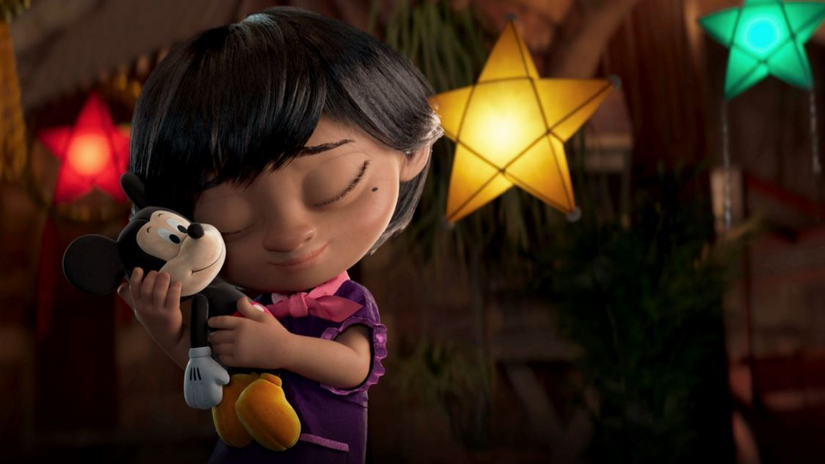On November 8th, I encountered a short film uploaded on Disney UK’s Instagram page titled “Disney’s Christmas Advert 2020?”. The film starts out at a night scene in the Philippines in 1940 with a little girl meeting up with her parents. Her dad gives her a Mickey doll by which she hugs lovingly. The film then fast forwards to 2005 when the little girl has become an elderly grandma living with her granddaughter. Every Christmas, the two family relatives would make paper lanterns together. They both would have the Mickey doll, which became a little worn out over the years, by their side, symbolizing the grandma’s childhood to the present day with her granddaughter. However, it wasn’t until one Christmas that the granddaughter decided to go out with friends, which broke the grandma’s heart. She looks at her Mickey doll with a sad expression on her face and then heads upstairs. Upon her arrival back home, the granddaughter feels bad for ditching as she looks at the Mickey doll and an old black and white photo of her grandma when she was a little girl. To make up, she surprises her grandma with decorating the entire home with paper lanterns. She then gifts her with the Mickey doll, fixed up and good as new. The film ends with the two in a loving embrace as the scene ends with the film’s title, From Our Family to Yours.
Disney UK had this entire film reflect on the Christmas season and the deep meaning behind its celebration based on Filipino culture and traditions. Fun fact: Filipinos start celebrating Christmas as early as September! This is due to the temperatures slowly decreasing due to the “-ber” months (SeptemBER, OctoBER, NovemBER, DecemBER). Celebration would end on January 6th during the Feast of the Three Kings. Thus, the Philippines is known to be the country that celebrates Christmas the longest!
Upon watching this film, I felt remarkably touched by its humbling and heartwarming story; as a Filipino, I felt so represented and seen. I deeply identify and feel so proud to be Filipino since the culture of the ethnic group of people I am a part of is being shown in such an accurate and touching way. But to all the non-Filipinos who have watched the film, they may have a sense of confusion and curiosity about the film. Being someone of Filipino origin, here are characteristics of Filipino culture that were presented throughout the film!
The film introduces the Philippines late at night in the 1940s with an establishing shot of the night scene. The left side of the frame includes a Catholic church and as the shot pans down it shows a small town plaza with colorful star-shaped paper lanterns lighting up the night sky. It’s no surprise and makes a lot of sense to us Filipinos that the story would start at night with a Catholic church in the background. We have a Catholic tradition called Simbang Gabi, or “night mass” in Tagalog. From December 16th-24th around 3am until 5am, there is mass held at church. The exception to the 3am starting time is on Christmas Day, when the mass would start at midnight instead.
We are then introduced to a little girl who runs up to a man addressing him as tatay, which means “dad” in Tagalog. Therefore, the man the little girl approaches and the woman beside him are her parents. As her tatay puts her back down after lifting her up in greeting, she then places his hand on her forehead. This gesture is a traditional practice called mano po which is used towards elders (moms, dads, aunts, uncles, grandmas, grandpas, etc.) as a sign of respect. Additionally, if you listen very closely, you can hear a faint voice shouting out “Balut!”. Balut is a boiled duck embryo eaten from the shell; it is a common street food that is eaten all over Asia. What is also seen within the scene of the family meeting up is a vehicle known as a jeepney. They were given to the Philippines by the U.S. during World War II. After it ended, they were left in the country and are now used as a main mode of public transportation! The ones in real life, compared to the one shown in the film, are relatively longer and larger in size.
One element of the film that I am most proud to be implemented in is the moreno, or dark, skin color of the characters. Most Filipinos possess dark skin complexions so to see such accurate skin color is incredible. There is a continuing issue with colorism in the Philippines with lighter skin being the ideal beauty standard and moreno skin being shamed as not beautiful. The film displaying the characters with such a skin color challenges that beauty norm while also creating a representation of the different Filipino skin characteristics (the mole too)!
The film transitions to the year 2005 where the little girl is now an elderly woman. There is a shot with the Mickey doll, now old and faded in color, on the left side, a white aluminium box in the middle, and photo frames on the right side. At the back is a paper that says “To Lola”; Lola means grandma, who the little girl is now referred to as. The grandma now lives with her granddaughter and pet dog. Every Christmas, the two of them would make paper star lanterns together as an annual activity of bonding. Specifically, they are called parols, which is only seen and made exclusively throughout the Christmas season. They can look as simple as the ones from the film, but typically we would use more detailed glass parols. These Christmas decorations are also displayed in Simbang Gabi masses and vary in many sizes from very small ones to huge ones.
A timely montage exhibits the granddaughter growing a lot older and becoming more mature looking as her and Lola make parols together as the years go by. During one Christmas when the granddaughter decides to head out with friends instead, leaving Lola at home heartbroken, she decides to make it up to her by decorating the entire home with parols. As the shot of the grandma looking in awe of the star lanterns, the scenery changes from the home to a close view of the Catholic church from the beginning of the film. The grandma receives a glimpse of her past as a little girl, indicating the Christmas decorations as a sentimental connection with her childhood from the present timeline as a Lola.
The film ends with the granddaughter gifting Lola with the Mickey doll that has always stuck by their side while doing their annual parol making activity; they then happily hug. The ending suggests that family is the most important priority when celebrating Christmas. That is so true for us Filipinos; we value family very dearly so this ending was beautifully crafted to emphasize that particular characteristic.
Overall, the story hits me personally as a Filipino to see representation and the accuracy of my people, and from Disney! I am so eternally grateful to see and identify with this film alongside my kababayans! I very much recommend watching this genuine and emotional work of art to commemorate the Christmas spirit within you! Maraming salamat po Disney!
To watch the film, go to this link. Enjoy!



